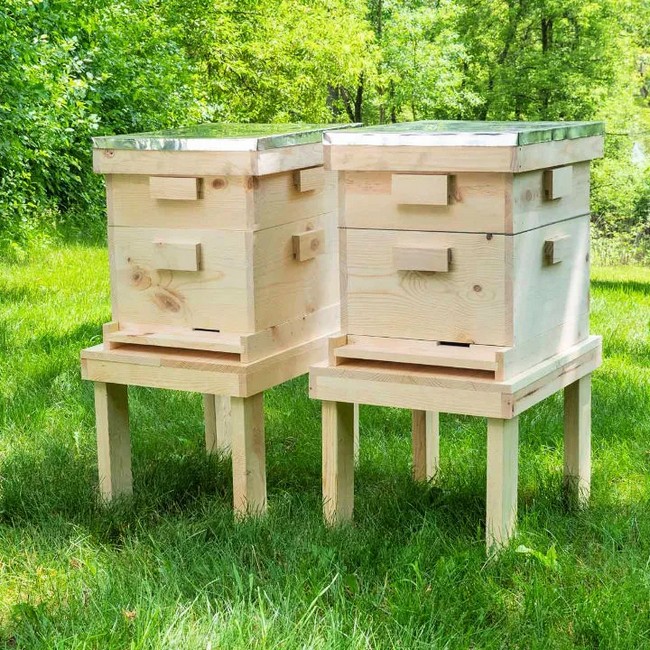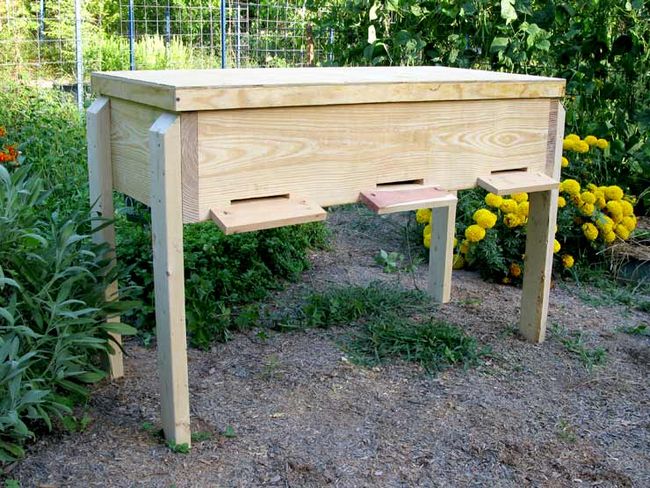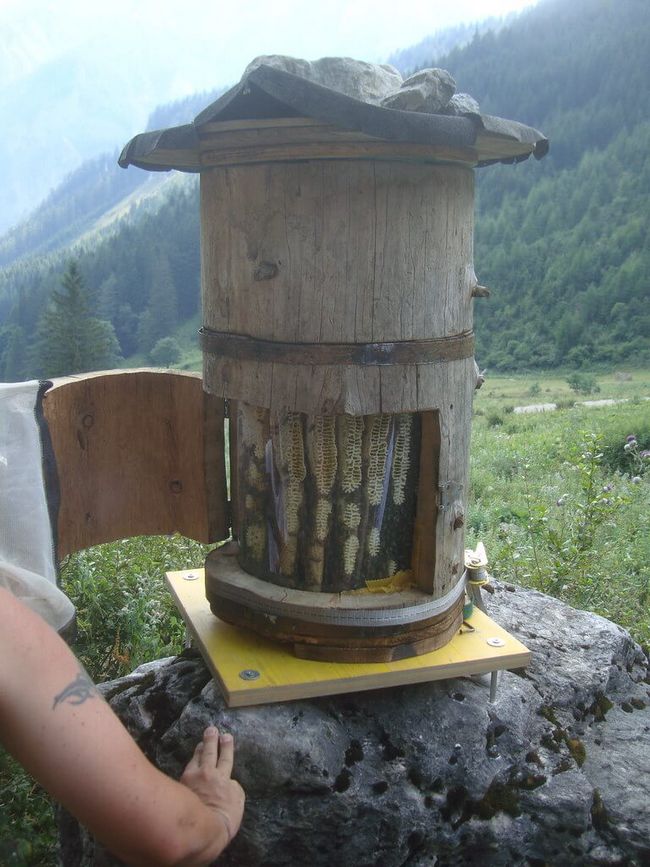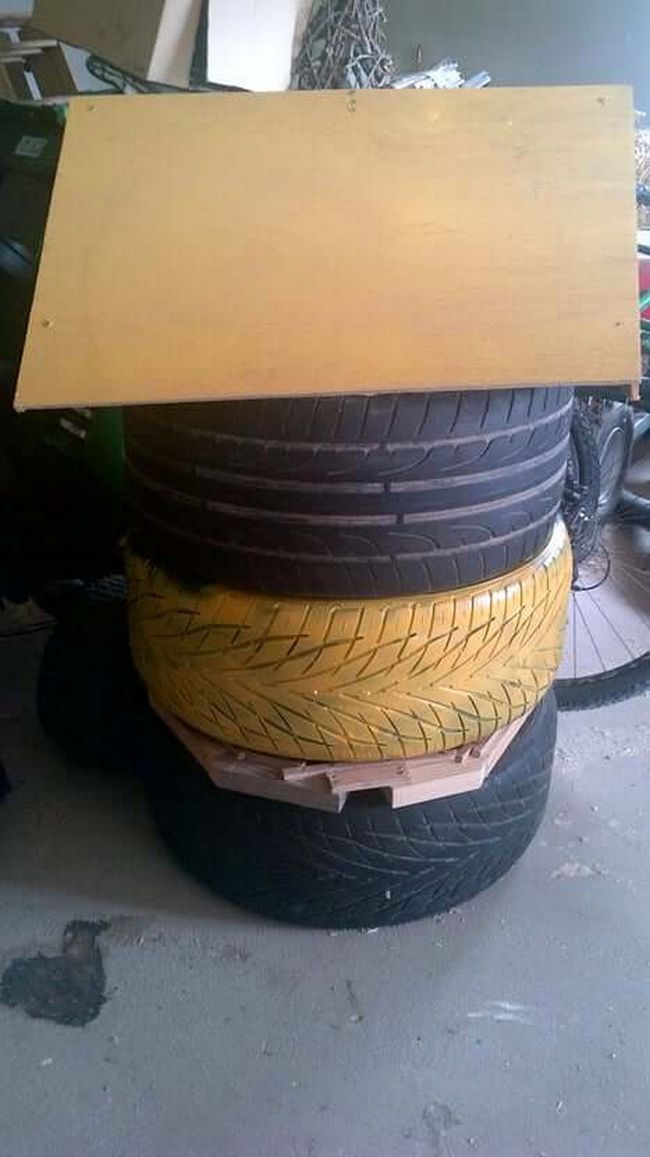Wooden DIY Beehive Plans
Beekeeping will help your garden flourish and take care of the bees simultaneously. Bees are our vital pollinators, so this skill is rewarding and beneficial to our planet. We will show you how to build your hive, safely handle the bees, and make all-natural honey, too!
These small backyard bee hives are a great way to plant a beehive in your garden. These plans provide detailed information on where and how to build the perfect bee hive planters and tips for growing new colonies. These beehives allow you to build your backyard beehives.
Our beekeeping plan guide offers the information needed to build a functional and safe bee house. The ideas in this series have been tested and re-tested by beekeepers worldwide. Whether a beginner or an avid beekeeper, these plans will be a blueprint for success!
Benefits Of Following These Beehive Ideas
If you love honey and want to know more about beekeeping, these plans will give you the tools to build your hive from scratch. They also have an excellent ventilation system, which may be important if you're keeping your hives inside; you’ll want to ensure that air gets into your hives even on cold mornings. These beehive plans are easy to follow and let you construct your first hive in a weekend.
DIY Cow Beehive

Step into the fascinating world of beekeeping with this user-friendly DIY guide. Learn how to build your Honey Cow - a cost-effective and natural top bar bee hive.
Making Of This Beehive:
Materials needed:
- 55-gallon plastic barrel, preferably food-grade
- 22 feet of 1”x2” nominal lumber
- 46 feet of 1½”x1” lumber
- 2 X 8 feet of 2”x4” nominal lumber
- A 3 feet by 4 feet piece of tin
- 20 - 1½” wood screws
- 10 - 2” wood screws
- 8 - ½ “ screws
- Bungee Cord or tie wire
- 45 feet thin molding OR natural fiber string and beeswax
Tools require:
- circular or jig saw
- drill
- tin snips
- tape measure and marker
To begin with, take a 55-gallon food-grade barrel and slice it in half lengthwise, ensuring it has a bunghole. Once it's cut, you need to strip it clean thoroughly and rub beeswax on the inside.
After your barrel is prepared, you must create a supporting framework. For this, use pieces of 1" x 2" lumber and attach them to the legs that you've made from 2" x 4" lumber. Next, cut about 24 bars from 1 ½" x 1" lumber. Be sure to attach a guide to each - it can be a strip of molding, a piece of twine, or a groove filled with beeswax. After that, you need to construct a roof.
Use the same 1" x 2" lumber for constructing a frame, then fasten a piece of tin to it. It should fit snuggly over the barrel framework but still leave a tiny gap on all sides. Fasten it securely with a bungee cord or tie wire. When all this is done, your handmade hive is ready and patiently awaiting its new buzzing inhabitants!
How To Build A Beehive

If you wanna harvest honey by yourself in the coming season, then following this easier beehive-making can be a beneficial option for you.
Materials Required
- 1-½” Trim-head Screws
- 1-¼” Trim-head Screws
- ¼” Plywood
- 1x10 Board
- 1x2 Board
- 1x3 Board
- 2" Trim-head Screws
Tools Required
Imagine the base of your beehive, which is also the only exit for the bees. You can adjust its size to control how much ventilation and warmth the hive has during the cooler months. Now picture the bees in their home, these boxes called 'hive bodies'; these contain the comb frames. In the honey season, we use something special designed to keep the queen bee separate from the honey production. When the bees are busy, they start to collect surplus honey in a spot we call the 'honey super.'
The bonus is that this honey can be harvested. Every frame in the hive is where bees build their honeycomb, and all they need to get started is a single sheet of beeswax foundation. Then there's this tray with a hole and a small notch; it's the inner cover, and we use it to keep air flowing through the hive. Finally, picture an outer cover that shields our busy bees from weather changes: it's the roof of their home."
Easy DIY Beehive Plan

Building a beehive might not be cost-effective unless you have access to wood at a low cost, but many people appreciate the task and the idea of creating a unique item for their beekeeping project. It's important to remember that bees prefer certain conditions, such as tight fittings that don't let in the rain, small and easily guarded entrances, and precise interior size. It's important to ensure your beehive meets the bees' preferences, not just your own.
Cheap DIY Beehive

If you want to start beekeeping but don’t want to make a big investment, the Warre hive may be the way to go. The stacked design offers a compact footprint and makes adding or removing boxes easy. This budget-friendly model is ideal for people looking for a small hive to start their apiary on a budget.
DIY Beehive Plans

This beehive cabinet is a great place to house your bees. This makes it a great introductory project for new beekeepers who want to try their hand at raising their bees without spending too much money or time! Made from wood scraps and ash, this beehive will protect your bees while allowing you to harvest honey year after year.
You'll need the following things on hand for making this beehive.
- Wood
- Stapler and staples.
- Strong outdoor-use glue
- Cutting tool
- Wax foundation
Making: Start by building a base with a ¼" raised edge and attach legs. Next, create a box for the brood and honey, adding handles for better grip. Construct a roof with overhangs for rain protection. Finally, cut and assemble frames, ensuring they fit into the box with enough space for bees. Secure all parts together and ensure there are no gaps.
Pallet Beehive Plan
The Pallet Beehive Plan is a great way to reuse and upcycle wood as a beehive project. The reusable frames are made from discarded wooden pallets or skids, making them cheap and easy to build. It is a good way to build your own beehive by reusing and upcycling pallets or wooden skids.
You'll need the given materials for making this beehive:
- ¾" and ⅜" wooden slats from old skids
- 1 ½" construction screws, spiral nails or staples
- Glue
- Leftover 2x10 boards
- 16 gauge wire
- Good quality outdoor latex paint
Procedure For Making: We'll start by shaping wooden slats into two box frames for the hive's top and bottom pieces. For the inside, we'll make about 10-inch tall boxes called honey frames. For the wax comb, we can cut thin strips and fit them into these frames. Finally, we'll add extra wood to the top frame for convenience in lifting and conclude by giving the hive a coat of outdoor paint. Safety is paramount in the process.
Easy To Make Beehive Plan

The Langstroth Hive Plan is a long model suitable for those who want to handle the bees themselves and harvest honey. It has thick walls, keeping the hive warm in winter and cool in summer. Legs positioned at the bottom of hives keep mice and other wildlife out. The feet are designed to be out of reach of rodents and other wildlife, yet they can be easily removed at harvest time to extract the honey with minimal stress on the colony.
Get the following materials on hand:
- Two-by-twelve pine
- Pine plywood
- Two-by-four untreated
- Wood glue
- 3-½ deck screws,
- 2-½ deck screws
- 1-⅛ deck screws
- Rigid insulation,
- Exterior acrylic primer/sealer
Making Of This Beehive: Cut your board into four pieces for the walls. Add a rabbet for the frame rests and carve three entrances in one board. Assemble the box, add another rabbet, create additional hive parts with plywood, and secure the bottom. Attach four legs and a landing strip. Assemble and affix the top, insert the insulation, and seal and paint the hive. Install at a slight forward incline and cover the frames with burlap. Consider adding a screen bottom board for maintenance.
Top Barrel Beehive Plan

A 55-gallon barrel can be converted into a hive ready to accept bees and allow you to harvest honey right from home. Our Barrel Beehive Plan features a 55-gallon drum (with metal hoops) converted into a beehive, complete with nesting boxes. It also includes plans for a ventilated top cover and a removable outer cover that provides easy access to check on the bees. This is a one-day project, ideal for the beginner beekeeper.
You'll need:
- 55-gallon drum
- Standard landscape timbers
- Measuring tape
- Radial miter saw
- 2x4 wood pieces
- Jigsaw or reciprocating saw
- Circular saw with a guide
- Screws
- Drill
- Chisel and hammer
- Cove molding
- Ring shank nails
- Tin for roofing
- Barrel plugs
- Screws
Procedure for making: First, you'll need a 55-gallon drum, timbers, a saw, and a drill, among other tools. Cut four notched legs from the timbers to support a hive foundation frame made from the cut barrel. Create top bars with attached cove molding as space for bee combs, and lay them on the frame. Build a roof frame and add tin as a cover. Drilling holes in specific spots of your barrel helps regulate airflow and drain condensation. Always remember, the hive's location matters - it should get shade during the hottest parts of the day.
Holzer Style Log Bee Hive Plan

This DIY bee hive is made for those who have little experience in carpentry and would like to explore the ancient art of beekeeping. It doesn't use chemical treatments, so it's perfect for organic beekeeping.
The material list for this beehive is as follows:
- Suitable hive logs
- Plexi-glass
Tools:
- Chainsaw
- Bore cuts tool or drill
- Chisel
- Marker
Making: First, you need a log that's preferably rotten or hollow in the middle, but if you can't find one, a solid log works, too. If you're using a solid log, you must carve out the middle using a chainsaw.
Once you've got your hollow log, you create some notches for the hive's top bars, ensuring there's enough room for two bees to get through. This involves aligning and stacking the carved sections or 'supers,' as they're often called.
And if you want to make things a bit more fancy, you can add a viewing window to keep an eye on your bees. It's really that simple! Ensure you're familiar with your local laws before you start building, as not all places permit this kind of bee hive.
How To Make $hive Plan

The $hive Plan is a practical and economical woodworking project focusing on honey production. The Hive Box is designed so that it can easily be harvested with basic tools, enabling the beekeeper to cut down on costs. While this plan does not fully encompass all aspects of traditional beekeeping, it does address some serious considerations for small-scale beekeepers: transportation, cost efficiency, and ease of use. All you need is basic woodworking skills, or follow along and watch as it happens in front of your eyes.
You'll need the following materials:
- Plywood sheets of different sizes and thicknesses
- Mesh (1x)
- Frame runners (2x)
- Entrance disc (1x)
- Floor runners (25 x 25 x 460 x 2 of hardwood)
- Galvanized steel sheet (610 x 610 x 1.5 x 1)
- House bricks (4x)
Tools Required are:
- Jigsaw
- Circular saw
- Hammer
- Cordless drill
- Set square
- Drill bits of various sizes
- Tape measure
- Marker pen
- Hide hammer
- 40mm hole saw
Building this beehive: Start by making the brood box. Cut an entrance hole and assemble it using waterproof wood glue and nails. Remember to keep the box square while you're putting it together. After that, paint the outside of the box and cut in some finger grips to make it easier to lift. For the roof, you must cut a galvanized steel sheet and bend the edges to create a lip. Use bricks or large rocks to keep the roof in place. Once you've built your beehive, you can get some bees from a catch hive or buy them from a local supplier.
Swarm Box Beehive Plan

Swarm Boxes can be used to attract bees from the wild or be used as a nucleus hive. This plan for a plywood swarm box will have you attracting bees from the wild, or you could start your colony with a nucleus hive. A swarm box is an artificial tree cavity replicated inside the shed or house you keep your bees in. It is designed to be open at the top and bottom so that a wild colony can move in of its own accord, or it can be used as an alternative method of adding bees to an existing hive.
Materials You Need:
- PVC pipe with an outside diameter of 36mm
- 5mm plywood
- Waterproof expanding wood glue
- Gloss, non-drip, one-coat exterior paint
- Fine mesh sheet
- ¾" beekeeper's Gimp pins
- Circular entrances
Tools You Need:
- Nail gun
- Electric drill
- Jigsaw
- Circular saw
- Hole saw cutter diameter 35mm
- Tape measure
- Set square
- Marker pen
- Thin latex gloves
- Dust mask
Making: Cut the plywood as per our measurements and stick them together to assemble the hive boxes. Always use waterproof glue. Remember to apply paint to make our hive weather-resistant. Give it six weeks to dry before we add the bees. Install a mesh floor in the bottom for proper ventilation and an entrance that we can close when moving the hive. If we think it'll help, we can build a feeder for sugar syrup. Lastly, we'll place the frames and foundation inside the hive.
You can also see DIY owl house plans to attract owls to your garden
Beehive In Bucket Plan

Create your bee-friendly planters with the Beehive in a Bucket plan. This easy-to-build bee hive serves as a winter home and pollinates flowers! The hive works by weaving together strips of wood that form an open box. Plant your annuals on top of the woven frame and add a PVC pipe as a center post for stability. The bees will love it! The hive sits inside a plastic bucket made from PVC plumbing pipe, making it easy to transport to your favorite flower garden.
The materials needed for this beehive construction:
- A bucket with a lid
- PVC pipe
- A plug for the bottom of the PVC pipe
- Tools for cutting holes in the bucket lid and PVC pipe
- An optional sliding PVC section for air vents
Making of this beehive:
Start by preparing a PVC pipe with a bottom plug to keep ants out, cutting holes near the top for bees to enter and exit. Cut a hole in a bucket lid that fits over this PVC pipe. Then, snap the bucket onto the pipe, flip it upside down into the lid, and plant the pipe assembly into the ground. Adjust the air vents in the pipe as needed using a slide-up/slide-down PVC section. Position the hive in a location that suits both humans and bees. This setup is a stationary hive designed to provide homes to bees rather than for honey harvesting.
DIY Beehive Plan With Tires

Old tires can be the framework for a DIY beehive. When flipped over, they make excellent houses for honeybees and other pollinators, providing shelter while using an underutilized resource. This plan provides step-by-step instructions on how to make your tire beehive.
This easy-to-follow tutorial is perfect for both beginners and experienced beekeepers. It will help create a haven for beneficial pollinators like honeybees, bumblebees, and butterflies.
Materials needed are:
- 3 or 4 Tires
- Some lengths of Wood
- Some Plywood
- Screws
- Hay
- Hot Glue Sticks
- Plastic Bags
Tools
- Saw
- Screwdriver
- Glue gun
How To Make This Beehive:
Imagine you've got some spare tires. What if I tell you that you could turn them into a beehive? Stack them together, then cut some wooden pieces according to that height. This will act as your hive's frame. To ensure it's cozy, stuff some hay into the rims and line the sides with plastic bags. Use any scrap plywood to create the top bar frames and an entrance. Now, for the roof, you lay two pieces of plywood across the top and attach wooden pieces at the sides and the middle. The fun part? You could spray paint the whole thing and waterproof the roof. Once you've done it, the last thing you'd have to do is add the bees! But remember, always be careful and wear protective gear while handling bees.
DIY Beehive Mason Jar

The Mason Jar Beehive is a unique and innovative way to learn about bees. This easy-to-assemble project includes a pine board with holes for 6 or 8 Mason jars. You can see the bees at work inside the jars, giving you an up close and personal look at what goes on in a beehive.
Materials you need are:
- An existing bee hive
- A board
- 6 to 8 Mason jars
To start Mason jar beekeeping, integrate Mason jars into your existing hive setup. You will need a board with holes drilled in it sized to fit 6 to 8 Mason jars snugly. Place this board on your hive box super and insert the Mason jars into the holes. Be patient, as bees may take some time to navigate the jars and begin building their combs inside. Once filled with honey, remove the individual jars for easy honey harvesting.
Best Guide If You Want To Learn How To Make Beehive

Building a beehive is an essential step in beekeeping. There are three main types of beehives: Langstroth, Top Bar, and Warre. Each variety caters to the different needs and skills of the beekeeper.
1. Langstroth Beehive: This is a widely used beehive type. It involves stacking boxes vertically, which contain 8-10 removable frames each. Variations include the Long Langstroth Hive and the 8-frame Langstroth Hive.
2. Top Bar Hive: This is the simplest beehive type, ideal for beginners. It allows bees to build their comb organically. The construction is typically straightforward, using readily available materials.
3. Warre Beehive: This type is mid-sized, balancing the other two options. Its compact and low-maintenance nature makes it a popular choice. However, it requires adding new boxes from the bottom.
Each hive type includes different plans and tutorials for construction. Picking the right one depends on your needs, budget, and skills.



Leave a comment